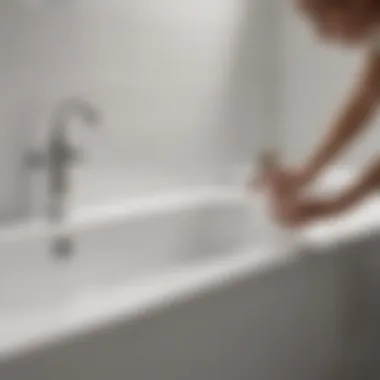Effective Methods for Unclogging a Bathtub


Intro
Clogged bathtubs are a frequent nuisance in many homes. Understanding how to effectively resolve this problem is critical for maintaining a functional and pleasant living environment. The common causes of clogs include hair, soap residue, and other debris that accumulate over time. While clogs can be quite frustrating, they are manageable with the right techniques and tools. This article explores a range of methods to fix stuck drains, looking both at traditional and modern approaches.
By gaining knowledge about the different ways to unclog a bathtub, homeowners can confidently address this issue efficiently. Identifying the specific problems leading to clogs allows for targeted solutions. The methods discussed here vary in complexity but all aim to restore smooth drainage without excessive hassle or expense.
Prologue to Bathtub Clogs
Bathtub clogs present a common yet often frustrating household issue. Understanding this topic is crucial for effective maintenance and management of your home’s drainage system. As bathtubs are one of the most frequently used facilities in a house, preventing and addressing blockages is necessary to maintain hygiene and comfort.
When discussing bathtub clogs, it is important to consider various factors like drainage systems, common causes, and methods for unclogging. Efficient drainage ensures a smooth flow of water, which is essential for everyday use. The greater the awareness of how clogs form and what contributes to them, the better equipped you are to take preventative measures.
Understanding Drainage Systems
In order to tackle bathtub clogs, one must first comprehend how drainage systems operate. The drainage system of a bathtub generally consists of pipes and fittings that channel water away, either to a sewage system or an on-site septic system. Proper functioning relies on these components working together unimpeded. Clogs can block this flow, leading to backups and functional failures. Knowing the route that water takes can help identify potential problem areas and inform maintenance efforts.
Common Causes of Clogs
Multiple factors contribute to bathtub clogs, and recognizing them is vital for effective management.
Hair Build-up
Hair build-up is a significant contributor to bathtub clogs. As individuals wash and rinse in the tub, hair can easily become dislodged and accumulate in the drain. This build-up forms a dense mass that can trap other debris, leading to a more severe blockage. Its common occurrence makes it an essential aspect to consider when assessing bathtub drainage issues. Addressing hair clogs using simple tools or preventive measures can save time and mitigate potential damages to the plumbing system.
Soap Residue
Similarly, soap residue contributes to clogs. Regular bathing introduces soap particles into the drain, where they can bind with hair and other materials. Soap can leave behind a greasy film, which collects waste materials and exacerbates clogging. Understanding this residue’s role is crucial for recognizing how best to maintain drainage systems. Simple cleaning techniques like rinsing the drain regularly may help to counteract these effects, keeping the tub functional for extended use.
Mineral Deposits
Mineral deposits often gain significance in discussions about clogs. Water hardness varies by region, and in areas where the water supply contains high mineral content, these deposits can accumulate inside pipes. Over time, these minerals harden and create significant blockages. Unlike organic materials, mineral deposits are harder to dissolve and require different approaches for removal. Understanding their implications allows homeowners to implement preventive measures, such as regular cleaning or using water softeners, to minimize buildup.
Initial Assessment of the Clog
Assessing a clog effectively can save Time and effort. Some people may try to remove the blockage without thinking about its nature. This may lead to further complications. Therefore, the Initial Assessment is crucial. It helps determine what approach is suitable for unclogging.
Good evaluations involve identifying symptoms and determining severity. Knowing the characteristics of symptoms can lead to better decisions about unclogging methods. Without clear understanding, efforts might be misdirected, prolonging the problem. This section concentrates on key symptoms one might identify and how to categorize clog severity.
Identifying Symptoms
The first step in dealing with a clog is understanding symptoms that appear. Some key symptoms include:
- Slow Drainage: Slow drainage often signals an impending clog. As water takes longer to flow down the drain, it indicates build-up within the pipes. This aspect is vital because it allows for early intervention before the situation worsens. A unique feature of slow drainage is that it often serves as a warning sign. Ignoring it can lead to more serious issues, like total blockage. Addressing it early can save effort and potential costs associated with more severe clogs.
- Gurgling Sounds: Gurgling sounds from the drain suggest air pockets struggling to escape due to an obstruction. This condition reveals another layer of complexity in the drainage system. It signifies that there might be a blockage further down, possibly affecting both the bathtub and other plumbing. Recognizing gurgling sounds can help in diagnosing issues quickly. It's generally considered beneficial to address these signs promptly to prevent escalation.
- Water Backup: Water backing up into the tub is a clear indication of a significant problem. This symptom usually signifies that the clog is considerable or, in some cases, a full blockage. Water backup often leads to inconvenience and potential flooding, increasing urgency for action. This symptom’s distinct characteristic is its visible manifestation, making it easy to identify but difficult to ignore. The discrimination of this type urges immediate action, as delay can lead to costly damages or more extensive repairs.
Determining the Severity
Understanding how severe the clog is plays a critical role in deciding the next steps. Differences exist between minor and major clogs, impacting unclogging method choices.
- Minor vs. Major Clogs: Identifying whether the clog is minor or major is crucial. Minor clogs can generally be resolved using basic tools, such as plungers and household items. These are often manageable and cost-effective options. In contrast, major clogs might require more advanced methods or professional intervention. This distinction makes it easier for homeowners to allocate resources appropriately.
- Assessing Duration: Assessing how long the clog has persisted also helps gauge severity. A recent clog might respond well to simple methods, while long-standing clogs may need more effort or expertise. The duration gives insights into how deeply the blockage is established, affecting drainage flow. Short-term issues often indicate a manageable situation, whereas prolonged obstruction suggests a more entrenched problem that might require comprehensive strategies for resolution.
Understanding the symptoms and their severity aids in making informed decisions. This preparation can mitigate risk and reduce the amount of time and resources wasted.
In summary, the Initial Assessment of the Clog is a foundational step in unclogging a bathtub. Recognizing symptoms and severity lays the groundwork for effective remedial actions.
Basic Tools for Unclogging


When tackling a clogged bathtub, it is essential to understand the basic tools available. These tools are fundamental in resolving the issue effectively. Equipped with the right tools, homeowners can often address clogs without needing professional assistance. This article examines common tools like plungers and drain snakes. Each tool has its specific characteristics, advantages, and considerations. Knowing how to use them properly is crucial for success.
Plungers
Types of Plungers
Plungers are common tools found in many households. There are mainly two types: the cup plunger and the flange plunger. The cup plunger works well on flat surfaces, whereas the flange plunger is specifically designed for toilets and bathtubs.
The key characteristic of plungers is their ability to create suction. This suction helps dislodge any blockage caused by hair or soap buildup. Their popularity comes from their effectiveness and low cost. The unique feature of a flange plunger is its rubber extension, allowing it to seal more effectively in the bathtub drain. However, choosing the right plunger is important. If you use the wrong type, it may not provide the necessary suction, making it a less effective choice.
Proper Technique
Using a plunger effectively requires a proper technique. Position the plunger over the drain and ensure a good seal. Then, push down and pull up rapidly, creating suction and pressure. The characteristic of this technique is the rhythm – you need to apply consistent pressure.
This approach is beneficial because it maximizes the likelihood of breaking up the clog without damaging the drain. One unique feature of using a plunger is that it can be very satisfying to see immediate results. However, if the clog does not respond to plunging after a few minutes of effort, it may indicate a more serious blockage that requires additional tools.
Drain Snakes
Manual vs. Automatic
Drain snakes are another valuable tool for unclogging bathtubs. They come in two main varieties: manual and automatic.
The main difference lies in their operation. Manual drain snakes require physical effort to navigate the plumbing, while automatic snakes offer a powered solution for deeper clogs. The key characteristic of manual snakes is their simplicity and effectiveness, mainly for minor clogs. Their popularity is due to their ease of use and low maintenance. Automatic snakes, on the other hand, can reach deeper blockages and are beneficial for more severe situations. The unique feature of an automatic snake is its motorized mechanism, which can simplify the unclogging process significantly. However, it may require a larger investment.
Usage Instructions
Using a drain snake involves some specific instructions. Start by inserting the snake into the drain until you feel resistance. Then, turn the handle to engage, or, in the case of automatic snakes, activate the power. The motion allows the snake to break down the clog.
The main characteristic of using a drain snake is its effectiveness at dislodging material from within pipes. This tool is advantageous because it can clear blockages that plungers cannot reach. However, it is important to use caution with a drain snake. If used improperly, it may damage the pipe, leading to further issues.
Effective unclogging often relies on understanding the right tools and techniques.
In summary, the selection and proper use of basic tools for unclogging can greatly impact the situation at hand. From plungers to drain snakes, each tool has unique characteristics that contribute to successful unclogging efforts.
Chemical Solutions
Chemical solutions play a pivotal role in addressing bathtub clogs. These substances are specifically designed to dissolve or break down the materials causing the blockage. Their importance lies in their effectiveness and speed, often providing a quick remedy for homeowners facing immediate drainage issues. However, while they can be potent tools, understanding the various types of chemical drain cleaners and the necessary precautions is crucial to optimizing their use.
Types of Drain Cleaners
Acidic Cleaners
Acidic cleaners are powerful formulations that utilize strong acids to disintegrate clogs. One of the main benefits of acidic cleaners is their swift action. They can quickly dissolve materials like soap, grease, and hair. This feature makes them popular for urgent situations where time is of the essence. However, their potent nature also presents a disadvantage. The use of these cleaners requires caution. If mishandled, they can lead to damage of pipes and pose risks to users.
Unique aspects of acidic cleaners include their ability to clear stubborn clogs that other methods might not effectively address. Nevertheless, the potential hazards involved necessitate careful application. Users should be mindful of these issues before opting to use acidic products on their plumbing.
Enzymatic Cleaners
Enzymatic cleaners utilize biological enzymes to break down organic matter, making them a more eco-friendly choice. The key characteristic of these cleaners is their non-toxic nature, making them less harmful to both users and the environment. They work effectively on organic blockages like hair and food remnants. This makes them a very beneficial choice for regular maintenance as well.
One unique feature of enzymatic cleaners is their prolonged action. Unlike acidic versions, these products may take longer to work but they also prevent future clogs by maintaining a clean drain system. Yet, their effectiveness may be limited when faced with heavy, solid obstructions. Users must evaluate the type of clog before choosing enzymatic cleaners as their go-to solution.
Safety Precautions
Safety is a paramount concern when using chemical solutions for unclogging a bathtub. It is essential to employ protective measures to prevent any adverse effects during the unclogging process.


Protective Gear
Using protective gear is crucial for anyone applying chemical cleaners. The key characteristic of protective gear, such as gloves and goggles, is that it guards against chemical splashes and skin contact. Given the potent nature of many drain cleaners, protection is not merely wise but essential. Wearing appropriate gear significantly reduces the risk of accidents. This makes protective equipment a beneficial aspect of the unclogging process, ensuring user safety remains a priority.
Ventilation
Ventilation is another critical safety measure when utilizing chemical substances. Proper ventilation helps to disperse any harmful fumes that may be released during the application of these cleaners. This aspect is crucial for maintaining air quality in the environment. Open windows or exhaust fans can aid in creating a safer workspace. The unique feature of ensuring good ventilation is its role in creating a safer experience for users. If neglected, poor air quality can lead to respiratory issues or other health concerns. As such, maintaining proper ventilation is vital.
Always prioritize safety when handling chemical drain cleaners; your health and safety are far more important than resolving a clog quickly.
Natural Remedies
Natural remedies represent a valuable approach in tackling bathtub clogs without the use of harsh chemicals. These methods often utilize common household items that are not only more environmentally friendly but also more affordable. Homeowners seeking to maintain a clean and efficient drainage system may find these solutions both practical and accessible.
The benefits of natural remedies include reduced risk of damaging pipes and fixtures that often comes with chemical cleaners. Moreover, these methods are often safer for household members, especially for children and pets. There is an inherent value in utilizing simple ingredients that can effectively break down clogs while avoiding the noxious fumes associated with many commercial products.
It is essential to consider the types of clogs being addressed. While natural remedies may not always work for severe blockages, their success in minor situations can be quite notable. Keeping some common ingredients on hand allows homeowners to immediately respond to minor clogs before they develop into bigger problems.
Baking Soda and Vinegar
Baking soda and vinegar is a classic combination known for its effectiveness in various cleaning applications. When utilized in unclogging bathtubs, this method can provide a simple yet effective solution.
To start, pour approximately one cup of baking soda directly down the drain. This powder works by absorbing moisture and disrupting buildup in the pipes. Following this, pour one cup of vinegar into the drain. The reaction between baking soda and vinegar creates a fizzing action that helps to dislodge debris.
After letting the mixture sit for about 30 minutes, it is advisable to flush the drain with hot water. This step helps to wash away any loosened materials. Many find this an easy and eco-friendly substitute for traditional chemical cleaners.
- Easy to use: Most households have both of these ingredients.
- Non-toxic: Safe for the environment and family.
- Cost-effective: Avoids expenses related to commercial drain cleaners.
Salt and Water Mixtures
Using salt combined with hot water is another natural remedy recognized for its unclogging potential. Salt serves both as an abrasive agent and a dehydrating substance, which can help break down various types of clogs.
Begin by boiling approximately one quart of water. Once at a rolling boil, add a half-cup of salt and stir until dissolved. Carefully pour this mixture down the clogged drain. The hot water works to dissolve buildup while the salt helps dislodge persistent debris.
This method is particularly useful for grease-based clogs, as the heat and salt combination can help to dissolve fats that may have accumulated. It is typically recommended to use this remedy periodically to help maintain clear drains.
- Simple ingredients: Often available in the kitchen.
- Grease cutter: Works effectively against grease-related clogs.
- Routine use: Can help prevent future build-ups.
Preventive Maintenance
Preventive maintenance is a critical aspect of maintaining a home, especially when it comes to plumbing systems. It involves regular activities aimed at reducing the likelihood of clogs and ensuring that your bathtub and drainage system functions smoothly. The importance of preventive maintenance cannot be overstated, as it saves homeowners from the inconvenience and expense related to severe plumbing issues.
Regular Cleaning Practices
Hair Traps
Hair traps are devices designed to collect hair before it enters the drainage system. They are often placed over the drain or inside the drain itself. One key characteristic of hair traps is their simplicity; they can be easily installed and removed for cleaning. This feature makes them a beneficial choice in preventing clogs caused by hair accumulation. The main advantage of using hair traps is that they capture loose strands, reducing the risk of blockage significantly.
However, maintenance is essential. Hair traps need to be cleaned regularly to remain effective. Otherwise, they can themselves become a source of blockage. Regular attention to hair traps can prevent further issues down the line.
Using Drain Screens
Drain screens serve a similar purpose as hair traps but offer added protection. They cover the drain opening, allowing water to flow while obstructing larger debris, such as soap residue and hair. The key characteristic of using drain screens is that they fit snugly over the drain, often coming in various designs to suit different types of bathtubs.
The unique feature of drain screens lies in their versatility; they can effectively filter out particles that hair traps might miss. However, like hair traps, drain screens also require regular cleaning. The main disadvantage is that if not properly maintained, they can become clogged themselves, reducing their effectiveness and leading to possible water backup.


Routine Inspections
Conducting routine inspections of your bathtub and drainage system helps to identify potential issues early. By regularly checking for signs of slow drainage or unusual water buildup, homeowners can take the necessary steps before problems become serious. Carrying out simple inspections can provide valuable insights into the condition of the plumbing. This proactive approach is essential in maintaining an efficient drainage system and averting costly repairs.
When to Call a Professional
Determining the right moment to contact a professional plumber is critical for addressing bathtub clogs effectively. Sometimes, the situation may appear manageable using basic methods, but underlying issues may require expert intervention. Calling a professional can prevent further damage and save time.
Signs of Serious Issues
Recurring Clogs
Recurring clogs represent a significant warning sign when dealing with bathtub drainage. If blockages keep happening despite regular cleaning efforts and unclogging techniques, it is prudent to consider this as an indication of more serious plumbing problems. Consistency in drain issues often suggests that there is a fundamental problem, such as a damaged pipe or a more extensive blockage deeper within the drainage system.
This is critical for home maintenance as ignoring these signs can lead to more expensive repairs later on. Unique characteristics of recurring clogs include their tendency to manifest over a particular time frame, often after specific activities like heavy usage of showers or baths. While persistent issues may seem minor initially, they increase in complexity, requiring unnecessary stress and resources.
Structural Damage Indicators
Structural damage indicators could be the result of long-term drainage problems. These include water stains, damp patches on walls or ceilings, or unusual smells emanating from the bathroom. This situation requires immediate attention from a qualified plumber. The key characteristic of structural damage is its potency to escalate quickly; over time, it can undermine the integrity of a home.
Evaluating structural damage indicators is beneficial as it highlights challenges that extend beyond mere convenience. Unseen water damage can lead to mold growth or destruction of essential materials within the home. Timely professional inspection ensures homeowners address these threats before they become substantial issues.
Choosing a Plumber
In many cases, a professional plumber is necessary to remedy clogs effectively. Selecting the right plumber involves careful consideration of various factors to ensure quality services.
Researching Credentials
Researching a plumber's credentials is crucial. Valid licenses, certifications, and insurance signify professionalism and quality work. This process includes verifying references and checking reviews from previous clients. It's a beneficial aspect of hiring because proper credentials indicate a plumber's ability to address complex plumbing systems efficiently.
The unique feature of researching credentials rests in its potential to prevent further complications. A qualified professional knows building codes and safety practices, minimizing risks associated with plumbing errors.
Evaluating Quotes
Evaluating quotes from different plumbers is an essential step before committing to services. Pricing can vary significantly among professionals, and understanding what is included in each quote ensures that you are not underestimating potential costs. A well-rounded evaluation includes recognizing additional fees for materials, labor, and follow-up services.
This is important for financial planning, as unexpected costs can arise during plumbing work. The unique feature of evaluating quotes lies in its multi-faceted approach, allowing homeowners to compare services functionally. This process empowers clients to make informed decisions that balance cost with quality.
The End
The conclusion of this article is significant as it summarizes the key methods for unclogging a bathtub, providing a solid take-away for readers who may be facing this common issue. It serves not just as a recap but also as a reminder of the various strategies that can be employed when experiencing drainage problems.
In revisiting the effective unclogging methods discussed, such as using plungers, chemical solutions, and natural remedies, readers gain a clear auditory of options. Each method presented has its own advantages and drawbacks, depending on the specific circumstances of the clog. For instance, chemical cleaners may offer quick results but come with safety considerations that must not be overlooked. On the other hand, natural remedies like baking soda and vinegar are appealing for those looking for safer alternatives, albeit potentially requiring more time and effort.
Beyond understanding methods, it is crucial for readers to acknowledge the benefits of regular maintenance. Prevention through routine cleaning and inspections can significantly reduce the chances of clogs developing, saving both time and frustration. The proactive measures stressed throughout the article empower homeowners to take charge of their drainage systems, consequently enhancing the longevity and efficiency of their plumbing.
Ultimately, this summary emphasizes that being informed about bathtub clogs — their causes, symptoms, and solutions — is essential for any homeowner. The ability to recognize when to address an issue independently and when to seek professional help is invaluable. In doing so, one can maintain a functional and stress-free bathing experience.
Recap of Effective Methods
The methods explored in this article encapsulate both traditional tools and innovative techniques:
- Plungers: A practical tool effective for minor clogs when used properly.
- Drain Snakes: Useful for reaching deeper blockages that ordinary tools cannot.
- Chemical Solutions: Quick-acting but require precaution for safe handling.
- Natural Remedies: Safe alternatives that can effectively combat buildup over time.
These methods provide a diverse toolbox for homeowners, catering to different needs and preferences. Each approach reflects a unique blend of speed, safety, and convenience, reinforcing the idea that no single solution fits all scenarios.
Encouragement for Prevention
Preventing clogs before they occur can conserve resources and minimize headaches. Regular upkeep is key. Some practical strategies to consider include:
- Utilizing Hair Traps: Installing traps can capture hair and debris before they enter the drain.
- Routine Cleaning: Regularly clearing out the drain helps prevent buildup.
- Periodic Inspections: Checking the plumbing system can identify potential issues early.
In summary, a proactive stance will yield significant long-term benefits. By prioritizing prevention through routine maintenance, individuals can not only extend the life of their plumbing systems but also reduce the impact and frequency of bathtub clogs. This approach promotes a functional home environment where bathing remains a simple pleasure instead of a stressful burden.







